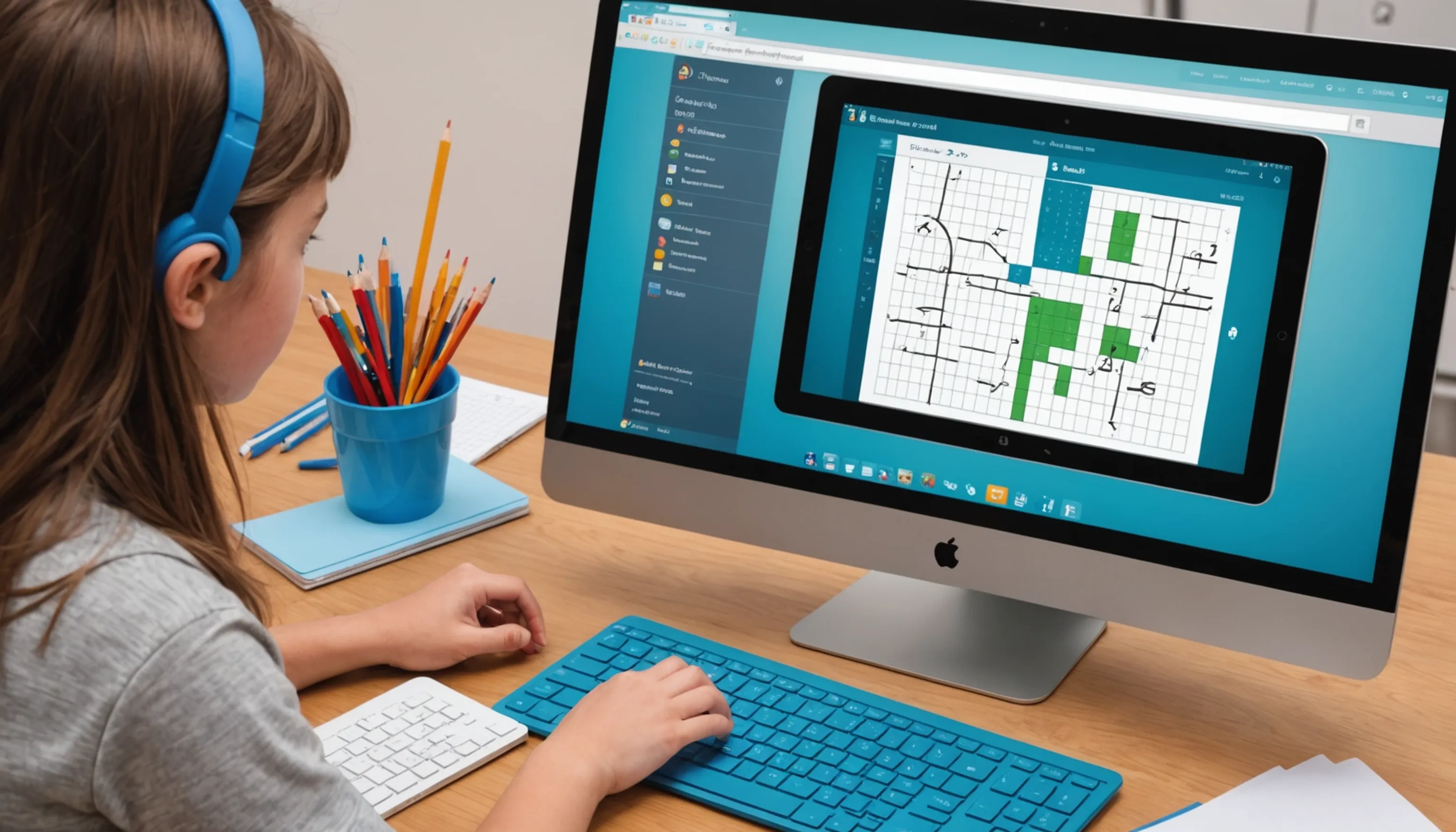Math Games Showing Real-Life Relevance of Math
 HvWHenry van Wagenberg
HvWHenry van Wagenberg
Math Games That Highlight Real-Life Relevance
Math games are an engaging way to show teenagers how math applies to real life. By incorporating fun and interactive elements, these games can illustrate essential math concepts in practical scenarios. For instance, games that involve budgeting or shopping can help students understand addition, subtraction, and percentages in a relatable context.
Furthermore, challenges like building projects or designing video games can demonstrate geometry and algebra in action. When students see the real-world relevance of math through games, it fosters a deeper understanding and appreciation for the subject, making learning both enjoyable and meaningful.
How Math Games Enhance Learning
Math games enhance learning by making abstract concepts tangible and engaging for students. They transform traditional math lessons into interactive experiences, encouraging students to participate actively. Through gameplay, learners can practice their skills in a low-pressure environment, which can reduce math anxiety and boost confidence.
One of the key benefits of math games is their ability to promote critical thinking and problem-solving skills. As students navigate various challenges, they learn to apply mathematical concepts in real-world situations. For instance, games that require budgeting or resource management help learners develop essential skills like addition, subtraction, and multiplication in practical contexts.
Additionally, math games often incorporate elements of competition and collaboration. Students can work in teams or compete against each other, fostering a sense of community and teamwork. This social interaction can enhance motivation and engagement, making math more enjoyable.
Moreover, technology has expanded the range of math games available. Online platforms provide a plethora of resources that can be tailored to different learning styles and levels. These digital games often offer immediate feedback, allowing students to learn from their mistakes and improve their skills.
Overall, incorporating math games into the curriculum not only makes learning fun but also reinforces key concepts in a way that resonates with students. By highlighting the relevance of math in everyday life through gameplay, educators can inspire a lifelong appreciation for mathematics.

Examples of Real-Life Applications of Math
Mathematics plays a vital role in our daily lives, often in ways we may not immediately recognize. Here are some real-life applications of math that demonstrate its relevance:
- Budgeting and Financial Planning: Understanding how to create a budget involves addition, subtraction, multiplication, and percentages. When individuals manage their finances, they use math to track income, expenses, and savings goals.
- Cooking and Baking: Recipes require precise measurements and conversions, such as adjusting serving sizes or converting units (e.g., cups to ounces). This involves fractions and ratios, making math essential in the kitchen.
- Sports Statistics: Analyzing player performance, calculating averages, and understanding probabilities are crucial in sports. Math helps fans and coaches make informed decisions based on statistical data.
- Construction and Engineering: Architects and engineers use geometry and algebra to design structures. They calculate areas, volumes, and angles to ensure safety and functionality in building projects.
- Shopping Discounts: Understanding sales and discounts involves calculating percentages. Shoppers use math to determine the final price of items and compare deals.
These examples illustrate how math is embedded in everyday tasks, making it not just a subject to be studied, but a practical tool that enhances our understanding of the world around us. Recognizing these applications can inspire students to appreciate the subject and its significance in their lives.
Popular Math Games for Teens
There are several popular math games that engage teens while enhancing their mathematical skills. One standout is Prodigy Math, an interactive online game that combines math practice with adventure, allowing students to battle monsters using math problems. Another favorite is Math Bingo, where players solve math problems to mark their bingo cards, making learning competitive and fun.
Additionally, games like 24 Game challenge players to use arithmetic operations to make the number 24 from four given numbers, promoting critical thinking. Incorporating these games into learning can make math enjoyable and relatable for teens.

Online Math Games and Resources
Online math games and resources have revolutionized the way students engage with mathematics. These digital platforms offer interactive experiences that make learning math not only effective but also enjoyable. One of the most popular resources is Khan Academy, which provides a plethora of instructional videos and practice exercises. Students can learn at their own pace and receive instant feedback on their progress.
Another excellent resource is IXL Math, which offers personalized practice questions tailored to individual skill levels. The platform adapts to each student’s learning needs, ensuring they are challenged appropriately.
For those who enjoy gaming, Prodigy Math integrates math skills into an immersive adventure game. Players solve math problems to progress through various challenges, making it a fantastic way to reinforce concepts while having fun.
Additionally, websites like Coolmath Games feature a variety of math-based games that encourage strategic thinking and problem-solving. These games often require players to apply mathematical concepts in creative ways, which helps in solidifying their understanding.
Moreover, platforms such as Math Playground provide a wide range of games and activities that cater to different age groups and skill levels. Teachers and parents can also find lesson plans and printable resources to complement online games.
Utilizing these online math games and resources can significantly enhance students' mathematical skills, making learning both effective and enjoyable in today’s digital age.
Board Games That Teach Math Concepts
Board games provide a hands-on approach to learning math concepts, making them an engaging tool for students. Many popular games incorporate mathematical principles, helping teens develop essential skills while having fun. Here are some notable board games that teach math:
- Monopoly: This classic game involves financial literacy, teaching players about budgeting, investments, and property management. Players must calculate rent, manage cash flow, and make strategic decisions, all while engaging in friendly competition.
- Sum Swamp: Aimed at younger teens, this game combines addition and subtraction within a fun swamp-themed adventure. Players navigate through the swamp while solving math problems, reinforcing basic arithmetic skills.
- Prime Climb: This colorful, mathematical board game introduces players to prime numbers and mathematical operations. By moving pawns around a spiral board, players engage in strategic thinking, learning about factors, multiples, and basic arithmetic operations.
- Set: While primarily a game of visual perception, Set requires players to recognize patterns and apply logic, which are crucial math skills. Players must identify sets of cards based on different attributes, enhancing their analytical thinking.
- Blokus: This spatial strategy game encourages players to think critically about geometry and area as they fit their pieces on the board without overlapping.
Incorporating these board games into learning can create a dynamic classroom or family game night, reinforcing math concepts in an interactive and enjoyable way.
Creating Your Own Math Games at Home
Creating your own math games at home can be a fun and educational activity for teens. Start by identifying the math concepts you want to reinforce, such as addition, fractions, or geometry. One simple idea is to make a math board game using a blank board, where players advance by solving math problems related to the concepts being learned.
Another option is to create card games, like a math-themed version of Go Fish, where players must match cards with equivalent values or solve equations. These homemade games encourage creativity while making math practice enjoyable and engaging.
Tips for Designing Engaging Math Games
Designing engaging math games requires creativity and an understanding of the concepts you want to teach. Here are some tips to help you create effective and enjoyable math games:
- Identify Learning Goals: Determine the specific math skills you want to focus on, whether it’s addition, multiplication, or geometry. This will guide your game design and ensure it aligns with educational objectives.
- Incorporate Fun Themes: Choose a theme that resonates with your audience, such as adventure, sports, or mystery. A captivating theme can make the game more appealing and motivate players to participate.
- Make It Interactive: Encourage players to engage actively with the game. Incorporate elements like teamwork, competition, or challenges that require players to think critically and apply math skills.
- Keep It Simple: Ensure the rules are easy to understand and the game flow is smooth. Complicated instructions can discourage participation, so aim for simplicity while maintaining the educational aspect.
- Include Variability: Create different levels of difficulty or various game modes to cater to different skill levels. This allows players to progress at their own pace and keeps the game fresh and challenging.
- Provide Feedback: Incorporate ways for players to receive feedback on their performance. This could be through point systems, rewards, or constructive commentary, helping them learn from their mistakes.
By following these tips, you can design engaging math games that not only reinforce mathematical concepts but also foster a love for learning.
Incorporating Everyday Scenarios into Math Games
Incorporating everyday scenarios into math games is an effective way to make math concepts more relatable and engaging for students. By using real-life situations, you can help learners understand the practical applications of math in their daily lives. Here are some strategies to achieve this:
- Budgeting and Shopping: Create a game where players manage a budget for a grocery shopping spree. Provide a list of items with prices, and ask players to calculate the total cost, determine discounts, or decide how to allocate their budget effectively. This scenario teaches addition, subtraction, and percentage calculations.
- Time Management: Design a game that involves planning a day with various activities. Players must allocate time for each task while ensuring they meet deadlines. This activity reinforces concepts related to time, such as addition and subtraction of hours and minutes.
- Travel Planning: Use travel scenarios where players calculate distances, fuel costs, or travel times. This could involve a map where players must determine the best route and estimate the total cost based on different factors, integrating geometry and arithmetic.
- Cooking and Recipes: Develop a game where players adjust recipes based on serving sizes. They can practice fractions, ratios, and conversions by scaling ingredients up or down.
By embedding these everyday scenarios into math games, you not only make learning fun but also help students recognize the importance of math in their lives. This approach fosters a deeper understanding and appreciation of mathematical concepts.
